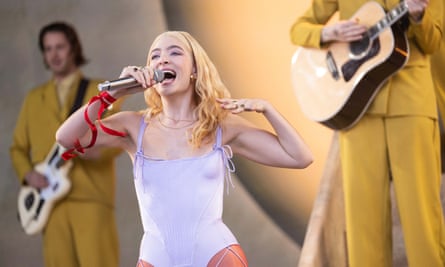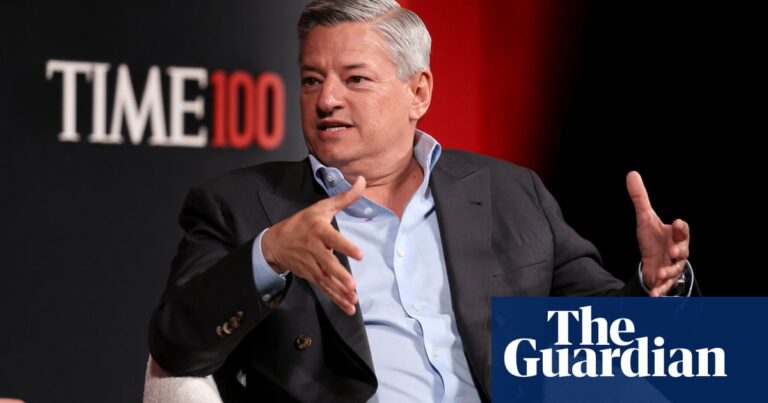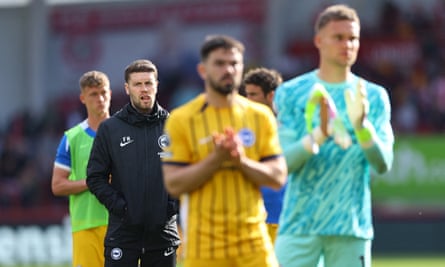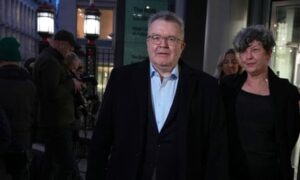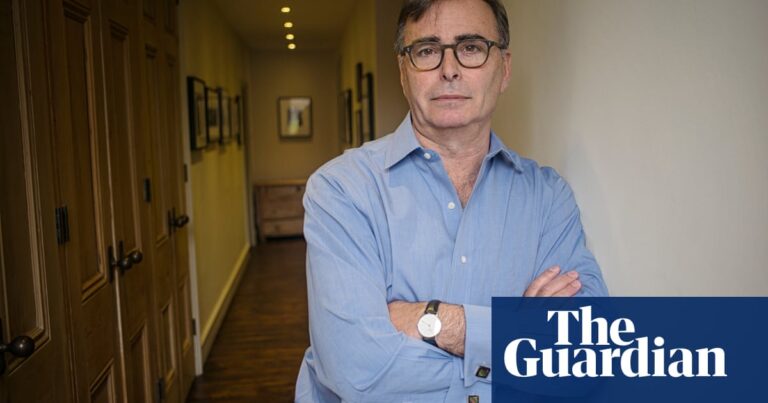‘They got his green polka-dot blouse right’
Richard Williams, biographer
If you’re the sort of Bob Dylan fan who knows stuff like the fate of the green woollen coat Suze Rotolo wore on the cover of Freewheelin’ (destroyed in an apartment fire) and how many times Dylan has performed Sad Eyed Lady of the Lowlands live (zero), you may well be worrying about A Complete Unknown.
Can Hollywood really be trusted to give a true account of the singer’s life between his arrival in New York in 1961 aged 20, and the musical explosion he detonated at the Newport folk festival four years later – the period in which he rose from complete obscurity to become, as was often said, the spokesman for a generation?
Such scepticism seems warranted when, early in James Mangold’s film, Dylan is shown singing Girl from the North Country before he had even visited England, where history records that he learned Scarborough Fair, the traditional song he would use as the template for his own great ballad. There will be similar unease when he’s seen taking Rotolo to that climactic event in Newport, from which she flees in tears (he didn’t and she didn’t).
The best weapon to quieten such anxieties is the performance of Timothée Chalamet, who might have seemed too sweet and pretty to play Dylan but completely nails not just the mumbling charm, the disconcerting gaze, the great hair and the casual cruelty but also, rather importantly, the singing and the playing.
Elle Fanning as a stand-in for Rotolo, the art student who was Dylan’s first New York girlfriend, and Monica Barbaro as Joan Baez, the star who took her place, bear much less resemblance to their real-life models. When Barbaro sings The House of the Rising Sun in a Greenwich Village folk club, she sounds closer to Rhiannon Giddens than to Baez. Rotolo, who died in 2011, is renamed “Sylvie Russo”, apparently because Dylan – credited as an executive producer – wanted to respect her preference for privacy but more likely because he realised how thoroughly the screenplay humiliates her. Not least in conveying no real idea of how profoundly she broadened his artistic horizons by introducing him to Brecht, Cézanne, the French symbolist poets and the civil rights movement.
Salient elements of the story, musical and sartorial, are carefully assembled, from the right guitars to the famous green polka-dot blouse, while events are compressed and merged in order to tell larger truths within a manageable framework. Most obviously, the shout of “Judas!” from an outraged British folkie in Manchester in 1966 is moved to Newport a year earlier and given an American accent. But the point is made, and there is a feeling that somehow, despite all the tricks that film directors play with the facts, justice has been done. Except, of course, to Suze Rotolo.
Richard Williams first saw Bob Dylan live at Sheffield City Hall in 1965. He is the author of Bob Dylan: A Man Called Alias.

‘Joan Baez did not fall hysterically into Dylan’s bed’
Liz Thomson, author
The fact that Bob Dylan likes the movie says a lot. Indeed, over the course of several meetings with James Mangold, he helped shape it, helped “fill in the cracks in the story”. We can be sure that Mangold wanted to please and flatter, and in diminishing or omitting so many people crucial to Dylan’s early career – Ramblin’ Jack Elliott; Dave van Ronk; Phil Ochs; Judy Collins; Terri Thal, his first manager; Robert Shelton, whose review led to the record contract; Peter, Paul and Mary, whose chart success raised both his profile and his bank balance – Dylan’s own star is magnified.
Take Suze Rotolo. Cultured and widely read, she was a full-time political activist when they met in 1961. She is shown explaining to a blissfully unaware Dylan about the civil rights movement and the brutal segregation in the south. Beyond that she’s fey, and in thrall to a guy she recognises is really a bit of a schmuck, even as she recognises his talent. In life, Suze was a young woman who knew her own mind. She read Françoise Gilot’s memoir Life With Picasso and decided she didn’t want to be anyone’s muse. By 1964 they’d split, which Dylan’s friends regarded as a betrayal.

Then there’s Joan Baez, a hugely significant figure in her own right who is routinely denigrated and dismissed by Dylan fans. She’s allowed to tell him “You’re really kind of an arsehole”, but she’s not given her due. Firstly she had two albums in the charts by the time of Dylan’s appearance at Gerdes Folk City in September 1961 and Shelton’s rapturous New York Times review. Her sensational performance at the 1959 Newport folk festival put her on the map. So to show her performing at a Gerdes open mic alongside Dylan is risible. She was scarcely in the Village and was not there the night of the Cuban Missile Crisis to fall hysterically into Dylan’s bed. At one point he sneers gratuitously, “Your songs are like an oil painting at the dentist’s office” – yet Baez made no attempt to write until the late 1960s. However, she was among the first to record his songs, and introduced him at concerts across the country, including the Hollywood Bowl, often to the dismay of many of her fans.
It’s yet more of the misogyny Dylan has displayed throughout his career. “Can you cook and sew, make flowers grow?” he asked as late as 1978 on Street Legal.
The film’s chronology is all over the place, events are invented or radically reshaped. Bizarrely, there’s not one establishing shot of the Village, which is a key element in the story – a “character”, really. But go see this enjoyable film, then use it as the launchpad for an exploration of the real artists and their music.
Liz Thomson is the author of Joan Baez: The Last Leaf, and the revising editor of Robert Shelton’s biography Bob Dylan: No Direction Home. She is the founder of The Village Trip, an annual festival celebrating Greenwich Village
‘Ed Norton’s Pete Seeger is the most moving of the lot’
Andrew Motion, poet
Dylan has always made disguise an essential part of revelation, and self-dismantling crucial to self-furthering. In his songs this takes multiple forms: the assimilation of existing melodic lines in the tunes themselves; the repeated reference to masks, avoidance and erasure in the lyrics.
In the clips or whole films of his life – or at least those in which he’s able to intervene – a similar thing happens: hard facts lie alongside inventions, and gnomic asides co-exist with honest assertions. All of which means that A Complete Unknown – the title gets straight to the point – continually asks us to wonder whether we’re dealing with a documentary, or a drama in which various kinds of certitude have been shuffled around for greater theatrical effect, or a fusion of the two.
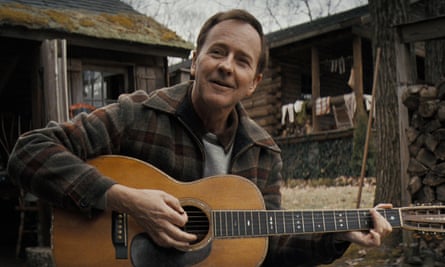
It’s not entirely clear that the film itself has decided which option to pursue. Sometimes it cleaves to well recognised chronology and substance (Dylan’s visit to Woody Guthrie, his thrilling arrival and almost immediate dominance of the New York folk scene), and at others it hauls around facts for dramatic advantage. It means that anyone watching A Complete Unknown with a reasonable grasp of Dylan’s actual biography is likely to end up resetting themselves at regular intervals, in order not to judge what they’re seeing by standards that don’t apply.
But perhaps we’re all used to this kind of mixing and matching, given the distortions endemic to docudramas. Besides, the performances of all the main characters are so brilliantly good, they quickly overwhelm every reason to quibble. Chalamet is uncannily plausible in voice, stance, dress, aspect and even laugh (that unexpectedly high snicker). Barbaro perfectly catches the head prefect aspect of Joan Baez’s personality, as well as the resilience of her admiration for Dylan’s genius in the face of sometimes gigantic provocation.
And Edward Norton as Pete Seeger is the most moving of the lot, as he allows for Dylan’s talent to be vastly superior to his own, without being able to adopt or endorse all its implications. He’s like John the Baptist – proud to enable, then left standing in the dust. And then there’s the music, which Chalamet makes sound fabulously beautiful and interesting. As it is. The record of a particular time and resonant in every time.
‘Chalamet captured that lovely, skinny, deep-thinker look’
Grainne Simms, superfan
I was expecting to hate A Complete Unknown. I’ve been listening to Bob Dylan since I was 16 and I’m now 77. I’ve seen him in concert about 62 times and my partner has gone more than double that. So we know the real story, and we care about it.
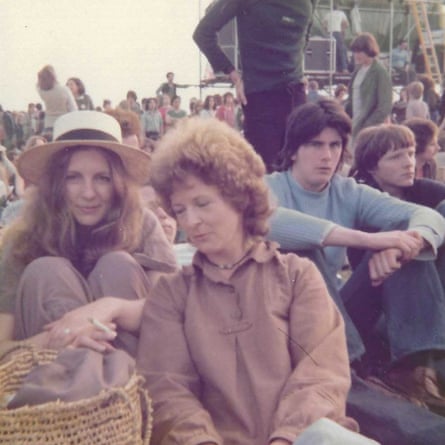
But I was wonderfully surprised by the film. I completely fell into it, right from the start, when he meets Pete Seeger and Woody Guthrie. All that social and political backgrounding was very deftly done I thought, and would be valuable context for people who might not know about, say, the impact of the Cuban Missile Crisis.
Sometimes younger people even say they haven’t heard of Bob Dylan – or if they have, he’s just some old man they can barely understand. But the film showed him as a really cool young guy, which might change that. And Chalamet nailed how enigmatic – and how self-actualised – he was, as well as how attractive.
When I was young I thought Dylan was the sexiest man alive, and Chalamet captured that lovely, skinny, lots-of-hair deep-thinker look, with the dark glasses and sunken cheeks. That said, I’m old enough to be his grandmother so I didn’t have those sexy feelings towards Chalamet myself – and I probably wouldn’t toward Dylan these days.
I wasn’t so sure about Barbaro as Baez. She just seemed like a pretty girl with a nice voice, rather than a towering talent with real presence. It also slightly bothered me that the character who’s a stand-in for Suze Rotolo wore an Afghan coat – they didn’t come to the US until the late 60s.
I didn’t mind about the changes to chronology, though it all did seem to happen much too quickly. Lots of scenes were really emotional and moving; in others I was laughing my head off. The iconic moment for me was when Seeger ran off to find an axe with which to cut the cables at the Newport folk festival. It’s something we’ve read about so often but it was wonderful to see dramatised. At the end I felt exhilarated – almost as much as after an actual Dylan gig.
‘Wow! Is that all we get of 1964?’
Lucas Hare, podcaster
The film reminded me of the career of Bob Dylan: it starts by wonderfully fulfilling people’s expectations then just does what it wants, no matter who it annoys. At first it gets lots right, then the chronology kind of unravels – which was either confusing or deliberate.

I absolutely adored the scene in which Bob meets Guthrie and Seeger – it’s a measure of how powerful I found it that I don’t care it probably didn’t happen. The film does a great job of showing why he took off so quickly in Lower Manhattan. But once he’s become successful, you start to see the missed opportunities. Dylan actually first played The Times They Are a-Changin’ the month before JFK’s death: a massive moment of talent smelling change round the corner. But the film didn’t go there.
Then it jumped from the assassination in 1963 to 1965 in three scenes. I thought: “Wow! Is that all we get of 1964?” The year he met the Beatles, came to England, met the woman he was married to for 12 years and first aired Mr Tambourine Man? For the rest of the movie, fans like me are going: “What? That didn’t happen in that order!”
But the moment Chalamet first hits the guitar strings you think: he really knows what he’s doing. Certain vowel sounds were pure Dylan. I’m always amazed by actors who can go that hard. There’s learning guitar, and then there’s learning to play guitar like Bob Dylan, and sing like him, and be him. Astonishing.
But even better was Edward Norton: the perfect balance of impersonation and capturing someone’s essence. Whenever I see footage of Seeger now, I’ll be thinking: “He looks just like Edward Norton.”
Lucas Hare is an actor and co-host of the podcast Is It Rolling, Bob? Talking Dylan
‘The guitar wasn’t quite right in Mr Tambourine Man’
John O’Connell, Dylan tribute act
I absolutely loved the movie. It really captured the feel of the early 60s folk scene and the story rolled along beautifully. I was so impressed by details like the old-fashioned microphones and the replica of Baez’s guitar.

I lead a touring Bob Dylan tribute band based in Liverpool, so I’ve spent a lot of time studying how he sings, and I was so impressed by both Chalamet’s phrasing and his guitar playing. It took me months to work out how to sing Highway 61, because Dylan sings across the beat, behind the beat, in front of the beat – it’s so difficult to nail down.
I never thought Chalamet would get as close as he did; it was fantastic. If I’m nitpicking, the rhythm guitar wasn’t quite right in Mr Tambourine Man; the strumming was a bit off. But it really didn’t bother me.
Simply Dylan is on tour
‘Some of the liberties they took were jarring’
Mike Pender, superfan
I’ve been a Bob Dylan fan since 1963, when I was captivated by Peter, Paul & Mary singing Blowin’ in the Wind on TV. They told the audience who had written the song, so I went into a record shop the next day and asked for “the Freewheelin’ Bob Dillon”.

I first saw Dylan in concert at the Odeon Cinema in Glasgow on 19 May 1966, which happened to be my 19th birthday. Best present to myself ever – especially as the centre stalls ticket cost £1 – despite him going electric for the second half of the concert.
I’ve seen him a few times since and was looking forward to A Complete Unknown. But I was underwhelmed: it didn’t tell me much I didn’t already know and some of the liberties taken with the facts and chronology were jarring. Maybe those with little prior knowledge of the events and characters might better appreciate the film.
I was particularly disappointed by the Suze Rotolo character. Fanning portrayed her as easily manipulated and often reduced to tears by her inconsiderate boyfriend. In reality (see her 2008 memoir A Freewheelin’ Time), Rotolo was a strong-willed young woman who did not see herself as subservient to anyone. She did not want to be “a string on Bob Dylan’s guitar” – as she describes herself in the film – but accepted him for who he was.
Anyone who knows only a little about Dylan going electric at the 1965 Newport folk festival would get the impression that he was booed off the stage and almost caused a riot. What actually happened is more nuanced.
The band were indeed very loud, which upset Seeger and others, and there were certainly some boos from the audience, but there were also plenty of cheers. As the 2007 documentary The Other Side of the Mirror shows, audience reaction was mixed. “When the legend becomes fact, print the legend,” runs the line from The Man Who Shot Liberty Valance. That could apply to A Complete Unknown as a whole.
Source: theguardian.com









